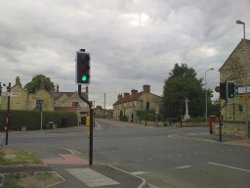According to the Driving Standards Agency, the current pass rate for the UK driving test is 43%.
It is probably safe to say that most of these failures could be avoided
if you make sure you take enough lessons and get enough practice. You should only take your
 test when your instructor tells you that you're ready and don't take the test just for the experience.
test when your instructor tells you that you're ready and don't take the test just for the experience.
As well as being able to drive, you have to have an awareness of what's happening around you, and to act accordingly. However, this is where the problems arise during the test, because nerves can play such a large part on how you are able to perform on the day. So many people say after their test: 'but I never do that normally!' The majority of pupils fail their test because of 'doing something silly' on the day that they wouldn't normally do on a driving lesson.
I have listed the top 10 reasons why most people fail the test :-
1. Not acting correctly at road junctions.
Its essential that you use the Mirrors, Signal, Position, Speed and look routine when you approach any kind of junction.Did you check that the new road was safe to drive into? That's essential when your turning either left or right. Was your speed on approach too high? If that was the case, then you might not have been able to stop if needed.
2. Reversing around a corner.
Most learners fail on this with either their control of the car of lack of observation. When reversing around a corner, its important to keep the car moving as slow as possible. you then have time to decide when to steer at the correct time. Its also important that you keep looking around for any other road users in the vicinity, and act appropriately.
3. Steering faults.
If you check on the fault list above, you will see that this category involves a lot of care of the steering wheel and the control of it. These are all bad habits that can be picked up in natural driving conditions, or from experienced drivers that drive wrongly. Don't let the wheel spin back after a turn or drive with any hands off the wheel for any longer than they have to be. Crossing your hands when turning is not a fault, unless you lose control of it.
4. Reverse parking faults.
Reverse parking can be one of the hardest of the manoeuvre's to do successfully. Like all of the other exercises, it needs very careful use of the controls to keep the car moving very slowly, so you have time to decide when to steer at the right time. You should also be aware of other road users and act appropriately if you see anyone else, while you're completing the task.
5. Making proper use of the gears.
Its essential to use the correct gear for the speed and road conditions. For example, if your approaching or driving through a lot of hazards, then its important to drive in a low gear whereas, if there are few hazards, the examiner will be expecting you to be in the highest gear available. A common error is to stay in a low gear (and this will include third gear) needlessly. Another area where people fail on gears, is forgetting to select 1st gear before moving off. It results in the car stalling. This could cause inconvenience to others, or have dangerous consequences.
6. Not using the mirrors correctly.
Why do you need to check you mirrors? Its essential to know if there are other road users are following behind you before you start any manoeuvre. Roughly speaking, you should check them between 25 and 50% of your driving time glancing in the mirrors. If you spend any more time, you are not paying enough attention to the road. An 'old wives' tale' says that you have to move your head when you make the checks. The examiner is trained to check your mirrors without you having to emphasize that your checking them.
7. Avoiding hesitation and driving too slowly.
Don't expect to pass if you stop somewhere unnecessarily. For example giving way to traffic where its safe to continue without stopping.The examiner will be expecting you to keep up with the flow of other road users within the legal limit, providing the road conditions allow you to. Driving too slowly when its safe to drive at the legal limit, will cause inconvenience to others.
8. Acting correctly when turning right.
As with anything that isn't driving in a straight line, remember your mirrors. Look at them before you do anything. Then indicate and move to the right of the lane you are in Wait for an appropriate gap in the oncoming traffic – you know how long it takes for you to turn right, the aim is not to hold other people up unnecessarily. If someone flashes you out, decide if its safe then move out.
9. Hesitation at junctions.
Your driving examiner will be expecting you to be able to judge gaps and the speed and distance correctly when either pulling out, or turning right. You should not pull out, or turn if you cause the approaching traffic to slow down or make them swerve.
10. Moving away from stationary positions.
The most common reasons for failing on this, are; moving off in the wrong gear; forgetting to turn the indicator off if you've used it; rolling back if you're moving off on a hill; or not looking around and checking your blind spot to make sure its safe go.
